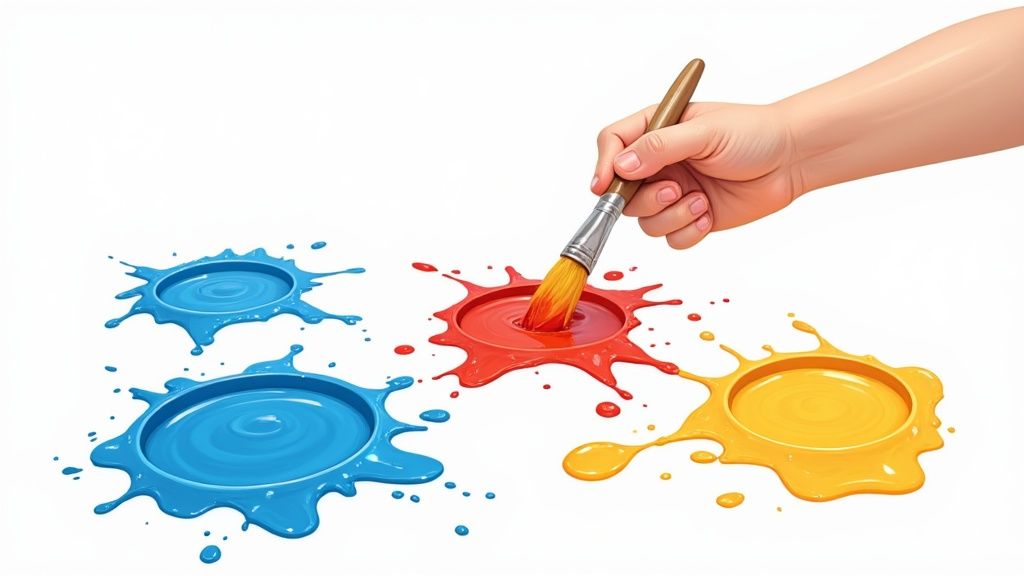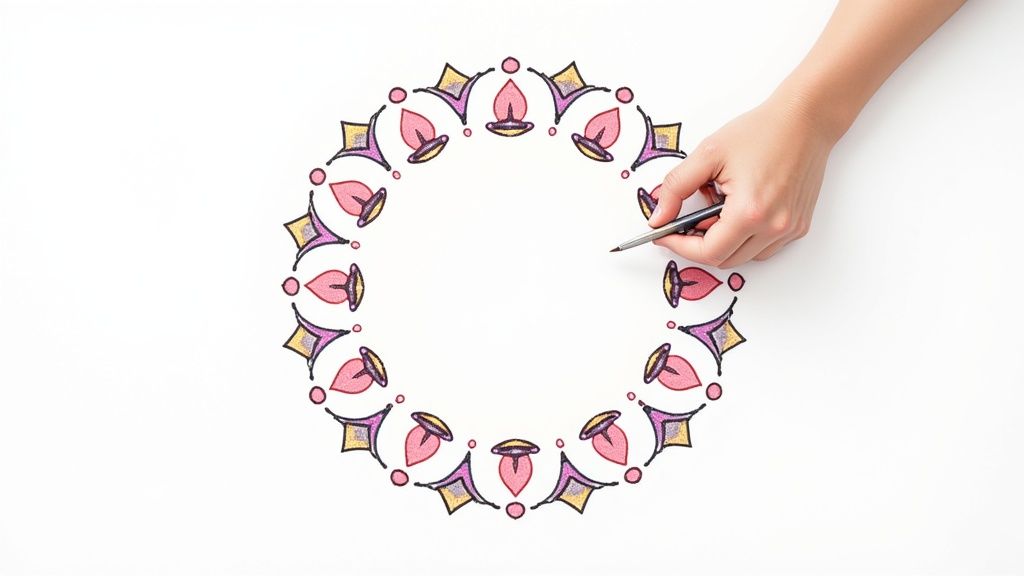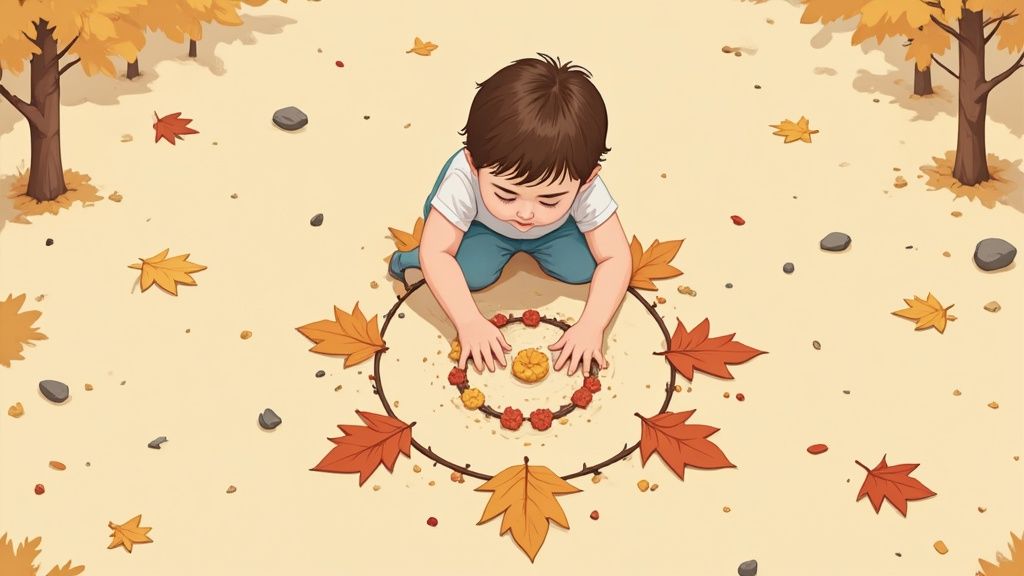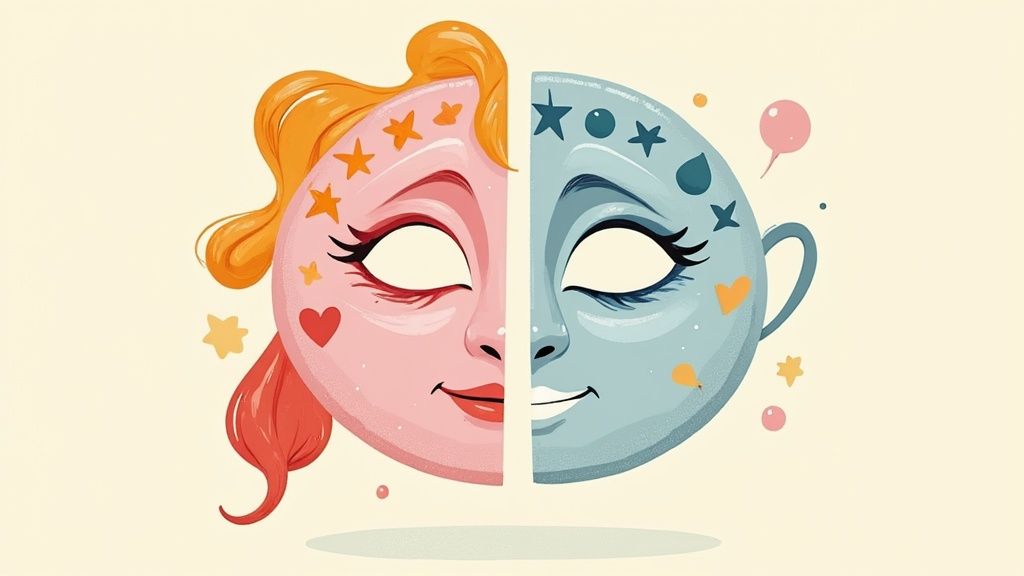Art provides a unique language for children to express complex feelings they might not have words for. This guide explores a range of art therapy activities for children, focusing on simple yet powerful techniques that parents and educators can use. From the calming focus of coloring to the expressive freedom of painting, these activities are designed to build emotional literacy, reduce anxiety, and foster creativity.
We'll provide actionable insights and practical examples for each activity, including specific coloring advice to help your child connect colors with emotions. Let's explore how you can transform a simple coloring session into a meaningful therapeutic experience. Beyond structured activities, it's also worth remembering that general creative hobbies are powerful tools for well-being. Many find that dedicating time to creative pursuits is a great way to DIY for mental health and process daily stressors. In the following sections, we will delve into specific exercises you can start using today.
1. Feelings Painting and Color Exploration
Feelings Painting is a foundational art therapy activity where children use colors and brushstrokes to express emotions they may struggle to verbalize. Instead of creating a recognizable image, the focus is on the process. Children choose colors that represent how they feel inside, whether it’s a fiery red for anger, a stormy gray for sadness, or a bright yellow for happiness.

This method makes abstract feelings more concrete and manageable. It's successfully used in trauma centers to help children process fear and in pediatric hospitals to manage anxiety about medical treatments. By linking an emotion to a color and a physical action, children gain a sense of control and understanding over their inner world.
How to Guide Your Child
- Prompt with feeling words: Start by asking, "If your happy feeling was a color, what would it be?" Use a feelings chart to help them identify emotions. For example, have them paint "what frustration looks like" or "what excitement feels like."
- Focus on the process, not the product: Avoid asking, "What is it?" Instead, try prompts like, "Tell me about the colors you chose," or "How did it feel to paint that big, red swirl?" The goal is expression, not a perfect picture.
- Connect colors to feelings: When coloring, you can suggest, "Let's use warm colors like red and orange for the parts of this character that feel brave." Or, "What color would you use for a secret, quiet feeling?" This builds emotional vocabulary.
- Validate their expression: Display the finished work to show that their feelings are important and accepted. You could say, "This painting shows so much strong energy. I'm glad you shared it."
This technique is especially powerful for children experiencing big life changes, grief, or overwhelming emotions. It provides a safe, non-judgmental outlet for self-expression. To explore this concept further with structured designs, you can discover more about our art therapy coloring pages here.
2. Mandala Creation and Coloring
Mandala art therapy uses circular, symmetrical designs to promote mindfulness, focus, and emotional regulation. Originating from spiritual traditions, the mandala's structure provides a contained, safe space for children's self-expression. The repetitive patterns and structured creativity help calm the mind, making it an excellent activity for managing anxiety and improving concentration.

This method is successfully used in schools to create calming transitions between lessons and in autism therapy programs to develop focus. Pioneered for therapeutic use by psychologist Carl Jung, mandalas allow children to organize complex feelings within a predictable framework, giving them a sense of order and control.
How to Guide Your Child
- Offer options: Provide both pre-drawn mandalas and blank circular templates so children can choose between coloring an existing design or creating their own from scratch.
- Encourage center-out work: Suggest they begin coloring or drawing from the center of the circle and work their way outward. This can mirror a process of internal exploration and "bringing feelings out."
- Give coloring advice for focus: For a calming effect, suggest using a limited palette of cool colors like blues and purples. To express energy, encourage warm colors. You can say, "Try coloring all the small circles first," to help them focus.
- Use diverse materials: Experiment with colored pencils for fine detail, markers for vibrant colors, or even collage materials to add texture and dimension to their designs.
This technique is particularly effective for children who feel overwhelmed or have difficulty focusing. The structured nature of the activity provides a grounding experience. Explore our collection of intricate and calming mandala coloring pages here to get started.
3. Emotion Collage Making
Emotion Collage Making is an expressive art therapy activity where children cut, select, and arrange images, words, and textures to create a visual representation of their feelings. Instead of drawing or painting, this process uses found materials to construct a narrative about their inner world, making it highly accessible for children who may lack confidence in their drawing skills.

This method helps children organize thoughts and make sense of complex experiences. It is often used in family therapy sessions where members create a shared collage to explore group dynamics, and in bullying prevention programs where kids create 'kindness collages' to focus on positive social interactions. The act of searching, choosing, and placing items is a reflective process that fosters self-awareness and identity exploration.
How to Guide Your Child
- Provide a rich variety of materials: Offer a wide range of magazines, catalogs, fabric scraps, newspapers, and textured papers. A diverse collection sparks more creative connections.
- Use specific, gentle prompts: Instead of a blank slate, suggest themes like, "Create a collage about your happy place," or "What do your worries look like?" A great practical example is creating a "Me Collage" with images of favorite foods, hobbies, and dream destinations.
- Encourage tactile exploration: Include materials like sandpaper, foil, and cotton balls. Ask how a texture feels and if that feeling reminds them of an emotion. "Does this rough sandpaper feel like an angry day?"
- Focus on the story: Once the collage is complete, use it as a conversation starter. Ask questions like, "Tell me why you chose this picture," or "What story does this collage tell?"
This technique is excellent for exploring identity, self-esteem, and complex feelings. It empowers children to express themselves using existing imagery, which can feel less intimidating than creating something from scratch.
4. Clay and Sculpture Work
Clay and Sculpture Work is a tactile art therapy activity where children use materials like clay or playdough to physically shape their emotions. This three-dimensional process allows kids to pound, squeeze, and mold a material, providing a powerful outlet for stress and feelings that are hard to express with words. The focus is on the act of creation, destruction, and recreation, which gives children a tangible sense of control.

This method is highly effective in trauma therapy, where children might create "worry monsters" to externalize and contain their fears. It is also used in anger management programs as a safe way to release physical tension. The sensory engagement of clay makes it a valuable tool in occupational therapy, helping with motor skills and sensory integration.
How to Guide Your Child
- Offer various materials: Provide options like air-dry clay, polymer clay, or simple playdough to see what texture your child prefers.
- Encourage physical interaction: Before starting a project, let them pound, squeeze, and roll the clay freely. This warms up their hands and serves as a direct sensory release.
- Create 'safe containers' or 'worry monsters': A classic example is having them sculpt a monster that represents their anxiety. Then, they can build a small clay box to "trap" the monster in, giving them a sense of control.
- Focus on the process: Instead of asking "What did you make?" try, "Tell me about how it felt to build that," or "I noticed you spent a lot of time smoothing that part."
This technique is ideal for children who need a physical outlet for their energy or are processing complex emotions like grief or anger. It empowers them by showing that feelings, like clay, can be reshaped and transformed.
5. Story-Based Drawing and Sequential Art
Story-Based Drawing combines narrative therapy with visual art by having children create comic strips or storyboards about their experiences. Children draw a series of connected images to tell a story, helping them organize thoughts, process events, and imagine alternative outcomes. This technique offers a structured way to externalize complex feelings and events.
This method is highly effective for making abstract situations concrete. It's often applied in school counseling to help children process bullying by drawing the scenario, in divorce counseling for creating 'family change' stories, and in PTSD treatment where children can construct trauma narratives in a safe, controlled manner. By creating a visual sequence, they gain perspective and a sense of control over their story.
How to Guide Your Child
- Provide simple templates: Start with pre-drawn boxes (3-4 panels) to reduce the pressure of a blank page. This structure makes the task feel more manageable.
- Use story prompts: Guide them with simple narrative structures like "Before, during, after" or "Problem, feelings, solution." For example, "Let's draw a comic about a time you felt scared and what happened next."
- Give coloring advice for storytelling: Suggest using specific colors to show the mood in each panel. For instance, a gray or blue palette could show sadness in the "problem" panel, while bright colors can show a happy resolution.
- Create empowerment narratives: A great prompt is to have them draw a "superhero" version of themselves overcoming a real-life challenge, which builds resilience and confidence.
This is one of the most powerful art therapy activities for children who thrive on structure and storytelling. It gives them a voice to articulate experiences they might otherwise keep inside. To get started with narrative-based coloring, you can find inspiration in our storytime coloring pages here.
6. Self-Portrait and Identity Exploration
Self-portrait activities engage children in exploring their identity, self-concept, and how they see themselves in the world. Rather than just drawing a realistic likeness, this activity uses symbols, colors, and metaphors to express internal qualities and feelings. It provides a tangible way for children to think about who they are, what they value, and their place within their family and community.
This method is powerful in contexts like adoption or foster care, where it helps children integrate their unique history and build a coherent sense of self. It is also used in support groups for transgender youth to safely explore gender identity and in multicultural programs to celebrate cultural heritage. By creating an external representation of their inner self, children can build self-awareness and strengthen their self-esteem.
How to Guide Your Child
- Offer creative alternatives: If a facial portrait is intimidating, try an "inside/outside" portrait where they draw their physical self on a paper outline and fill the inside with symbols of their personality, thoughts, and feelings.
- Use metaphorical prompts: Ask questions like, "If you were an animal, what would you be and why?" or "What colors represent your biggest strengths?" This can make self-expression feel safer and more playful.
- Focus on strengths with color: For coloring self-portraits, suggest they use their favorite color for their heart, a bright color for their brain to show smart ideas, or strong colors for their hands to show what they are good at doing.
- Avoid mirrors initially: For children with body image concerns, starting without a mirror can reduce pressure. The goal is to express their perceived self, not to achieve a perfect likeness.
This activity is ideal for children navigating identity questions, building self-confidence, or processing their personal story. It affirms that their identity is unique, valid, and worthy of celebration.
7. Nature Art and Outdoor Creative Expression
Nature Art combines the calming effects of the outdoors with creative expression, using found natural materials like leaves, sticks, stones, and flowers. Instead of traditional art supplies, children build and create with what the environment provides. This activity grounds children in the present moment, encouraging mindfulness and a connection to the natural world.
This method is a core component of wilderness therapy for at-risk youth and is used in grief camps where children create nature memorials. By using transient materials, it teaches important lessons about letting go and appreciating beauty in the moment. It is one of the most accessible art therapy activities for children, turning a simple walk into a creative adventure.
How to Guide Your Child
- Start with a mindful walk: Begin by slowly walking and gathering materials. Encourage your child to notice textures, shapes, and colors. Turn it into a game: "Let's find five different types of leaves."
- Create nature mandalas: Arrange the collected items like leaves, pebbles, and petals into a circular, symmetrical pattern on the ground to promote focus and calm.
- Paint stones with intentions: Have children paint stones with symbols, feelings, or positive words. They can keep them as "worry stones" or place them back in nature. For instance, paint a sun for happiness or a heart for love.
- Take photos of temporary art: Since much of this art is temporary, photograph the creations to honor the effort and preserve the memory. This teaches them that the process is as valuable as the product.
This approach is perfect for children who feel restless indoors or are experiencing sensory overload. It provides a tactile, sensory-rich outlet for expression. To bring the beauty of the outdoors inside, explore our collection of nature-inspired coloring pages here.
8. Mask Making and Role Exploration
Mask Making is a powerful art therapy activity where children explore different parts of their personality and emotions by creating masks. This technique allows them to create a tangible representation of their inner world, whether it's the "face they show others," a hidden feeling, or a superhero persona. The physical mask provides a safe psychological distance to express complex emotions.
This method is highly effective in trauma therapy, where a child might create a "brave" mask to help them face their fears. It is also used in social skills groups, where making emotion masks helps children practice recognizing and responding to others' feelings. By externalizing an identity or emotion onto a mask, children can explore it without feeling overwhelmed.
How to Guide Your Child
- Create an "Inside/Outside" mask: Decorate the outside to show the world how they feel and the inside to represent their private feelings. This helps explore internal versus external experiences. For example, the outside could be a smiling face while the inside is colored with dark, worried scribbles.
- Focus on strengths: Encourage the creation of a "superhero" or "strength" mask. Ask them, "What powers does this mask have?" to help them identify their own positive attributes.
- Use it for role-play: Once the mask is finished, facilitate a gentle role-play. You can ask, "Tell me about who you are when you wear this mask."
- Start simple: Use paper plates or cardboard cutouts for a quick and accessible activity. These simple materials remove pressure and keep the focus on expression.
This technique is excellent for children working on self-esteem, social skills, or processing difficult experiences. It offers a creative and symbolic way to understand the many different parts of who they are.
Art Therapy Activities Comparison Matrix
| Activity | Implementation Complexity 🔄 | Resource Requirements ⚡ | Expected Outcomes 📊 | Ideal Use Cases 💡 | Key Advantages ⭐ |
|---|---|---|---|---|---|
| Feelings Painting and Color Exploration | Low to moderate; mostly open-ended process | Low-cost basic supplies; adequate space | Improved emotional expression; sensory engagement | Young children, trauma, grief, verbal difficulties | Accessible, sensory feedback, low pressure |
| Mandala Creation and Coloring | Moderate; structured yet adaptable | Low to moderate; paper, coloring tools | Enhanced mindfulness, focus, emotional regulation | Anxiety, ADHD, autism, schools | Calming, portable, builds concentration |
| Emotion Collage Making | Moderate; requires material prep and choice | Moderate; mixed media, magazines, fabrics | Emotional distancing, decision-making, self-reflection | Identity exploration, bullying, eating disorders | No drawing needed, metaphorical distance, adaptable |
| Clay and Sculpture Work | Moderate to high; tactile and 3D manipulation | Moderate to high; clay, tools, space | Physical emotional outlet, motor skills, trauma processing | Trauma, aggression, sensory disorders, OT | Tactile, engaging for kinesthetic learners |
| Story-Based Drawing and Sequential Art | Moderate to high; needs narrative scaffolding | Moderate; templates, drawing tools | Organizes thoughts, processes events, develops narrative | Trauma, social skills, behavioral issues | Combines narrative and art, emotional distance |
| Self-Portrait and Identity Exploration | Moderate; requires sensitive facilitation | Low to moderate; drawing materials | Builds self-esteem, identity exploration | Identity issues, depression, trauma | Promotes self-reflection, tracks growth |
| Nature Art and Outdoor Creative Expression | Low to moderate; dependent on environment | Low; natural materials, outdoor space | Combines nature benefits with creativity, mindfulness | Ecotherapy, stress reduction, grief camps | Free materials, physical activity, environmental awareness |
| Mask Making and Role Exploration | High; multi-step, 3D, role-play element | Moderate to high; varied materials, prep | Psychological safety, emotional distancing, role exploration | Trauma, anxiety, identity, social skills | Engaging, memorable, integrates drama therapy |
Bringing Art and Emotion Together in Your Home
Integrating these creative experiences into your routine is about more than just filling an afternoon. The journey through feelings painting, mandala coloring, and story-based drawing provides children with a tangible way to process complex emotions they might struggle to articulate. Each activity, from sculpting a worry monster out of clay to creating a self-portrait, serves as a bridge between their inner world and the outside, fostering self-awareness and emotional literacy. The true value lies not in the finished product but in the process of creation and the conversations that follow.
The most important takeaway is that you don't need to be an art therapist to facilitate meaningful creative expression. By providing the space, materials, and a non-judgmental ear, you empower your child to build a vital emotional toolkit. The consistent practice of these art therapy activities for children helps develop resilience, improves problem-solving skills, and strengthens your connection. Remember to focus on the "why" behind their choices: "I see you used a lot of blue in your drawing. Can you tell me about that color?" This simple, open-ended curiosity transforms a simple coloring session into a profound opportunity for healing and understanding.
Actionable Next Steps for Parents and Educators
To continue this journey, start by choosing just one activity from this list that resonates with your child's current interests or needs.
- For the Quiet Child: Begin with something structured, like coloring a mandala. The repetitive patterns can be calming and provide a gentle entry point into creative expression without the pressure of a blank page.
- For the Energetic Child: Try something more physical, like clay sculpting or large-scale feelings painting, allowing them to channel their energy into their creation.
- For Building Connection: Work on a project together, like a family emotion collage or collaborative story-based drawings, to open up shared dialogue and build stronger bonds.
Ultimately, the power of these art therapy activities for children is their adaptability. They are tools to be molded to fit your child's unique personality and emotional landscape, offering a lifelong language for navigating life’s challenges.
Ready to put these ideas into practice with engaging, ready-to-use resources? Explore the vast library of themed coloring pages at Colortada. From intricate mandalas to expressive characters, you'll find the perfect canvas to begin your family's creative wellness journey. Visit Colortada today and turn any moment into an opportunity for connection and emotional growth.

